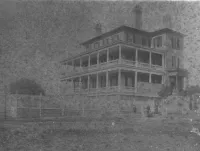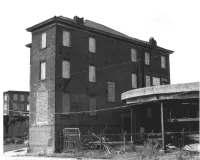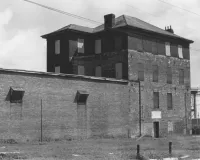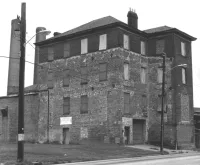Share what you know,
and discover more.
Share what you know,
and discover more.
May 17, 2010
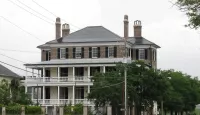
-

- Charmaine Bantugan
Josiah Smith Tennent House
The Josiah Smith Tennent House is a historic house in Charleston, South Carolina. The house was built by Josiah Smith Tennent in 1859 and placed on the National Register of Historic Places in 1979. In 1993, the city gave the property known as the Josiah Smith Tennent House to nonprofit Elpis Inc. At the time, the house was little more than a shell, and the nonprofit intended to restore the building as a community center. A restoration followed, aided by the community development grants from the city, private donations estimated in the millions, and a $1.73 million mortgage that Elpis took out on the building in 2003. The restoration received a South Carolina Historic Preservation Award in 2004. Elpis outfitted part of the building as a dental clinic, helped established a day care center there, and housed other nonprofit groups in the building. In March 2008, it was announced that Charleston would spend $1.4 million to buy the house when a nonprofit that received more than $1 million in municipal grants toward renovating the building as a community center defaulted on its mortgage. The small front yard of the building became the Philip Simmons Children's Garden, honoring the master blacksmith.
Josiah Smith Tennent House
The Josiah Smith Tennent House is a historic house in Charleston, South Carolina. The house was built by Josiah Smith Tennent in 1859 and placed on the National Register of Historic Places in 1979. In 1993, the city gave the property known as the Josiah Smith Tennent House to nonprofit Elpis Inc. At the time, the house was little more than a shell, and the nonprofit intended to restore the building as a community center. A restoration followed, aided by the community development grants from the city, private donations estimated in the millions, and a $1.73 million mortgage that Elpis took out on the building in 2003. The restoration received a South Carolina Historic Preservation Award in 2004. Elpis outfitted part of the building as a dental clinic, helped established a day care center there, and housed other nonprofit groups in the building. In March 2008, it was announced that Charleston would spend $1.4 million to buy the house when a nonprofit that received more than $1 million in municipal grants toward renovating the building as a community center defaulted on its mortgage. The small front yard of the building became the Philip Simmons Children's Garden, honoring the master blacksmith.
May 17, 2010
Josiah Smith Tennent House
The Josiah Smith Tennent House is a historic house in Charleston, South Carolina. The house was built by Josiah Smith Tennent in 1859 and placed on the National Register of Historic Places in 1979.In 1993, the city gave the property known as the Josiah Smith Tennent House to nonprofit Elpis Inc. At the time, the house was little more than a shell, and the nonprofit intended to restore the building as a community center. A restoration followed, aided by the community development grants from the city, private donations estimated in the millions, and a $1.73 million mortgage that Elpis took out on the building in 2003. The restoration received a South Carolina Historic Preservation Award in 2004.
Elpis outfitted part of the building as a dental clinic, helped established a day care center there, and housed other nonprofit groups in the building. In March 2008, it was announced that Charleston would spend $1.4 million to buy the house when a nonprofit that received more than $1 million in municipal grants toward renovating the building as a community center defaulted on its mortgage.
The small front yard of the building became the Philip Simmons Children's Garden, honoring the master blacksmith.
Posted Date
Oct 14, 2022
Historical Record Date
May 17, 2010
Source Name
Wikipedia
Source Website
Delete Story
Are you sure you want to delete this story?
Nov 27, 1979
Nov 27, 1979
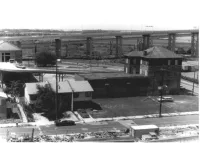
-

- Charmaine Bantugan
National Register of Historic Places - Josiah Smith Tennent House
Statement of Significance: The Josiah Smith Tennent House, located within the city limits of Charleston, South Carolina, is believed to have been built by Josiah Smith and Mary Ramsay Tennent circa 1859. The house is architecturally significant as a modified, detached Charleston single house exemplary of the Greek Revival influence and is historically significant both for its associations with locally prominent individuals and for its commercial use. Stylistic analysis and historic evidence indicate that Josiah Smith and Mary Ramsay Tennent constructed the house circa 1859 on property which had been conveyed to them in 1856 by her father, Dr. John Hyrne Tucker. A member of a prominent Charleston family, Tennent was a wealthy businessman and planter. He was a brick factor and was associated with the Planters' and Mechanics' Bank. In addition, he owned numerous tracts of land, including a plantation in St. James Parish, Goose Creek. An early volunteer for Confederate Service during the Civil War, Tennent served in Company A, Twenty-Seventh South Carolina Regiment (Gaillard's Regiment) until his death in 1864. Mrs. Tennent continued to reside in the house until 1870. Stylistic analysis and historic evidence indicate that Josiah Smith and Mary Ramsay Tennent constructed the house circa 1859 on property which had been conveyed to them in 1856 by her father, Dr. John Hyrne Tucker. A member of a prominent Charleston family, Tennent was a wealthy businessman and planter. He was a brick factor and was associated with the Planters' and Mechanics' Bank. In addition, he owned numerous tracts of land, including a plantation in St. James Parish, Goose Creek. An early volunteer for Confederate Service during the Civil War, Tennent served in Company A, Twenty-Seventh South Carolina Regiment (Gaillard's Regiment) until his death in 1864. Mrs. Tennent continued to reside in the house until 1870. Wulbern occupied the Tennent House until 1889, when he sold it to the Charleston Cotton Mills, a textile firm. (Established as the Charleston Manufacturing Company in 1880, the cotton mill went bankrupt in 1888 and was reorganized under the new name that same year.) The complex of buildings associated with the mill covered several city blocks, bounded roughly by Drake Street on the north, Columbus Street on the south, American Street on the west, and East Bay Street on the east. A part of this complex, the Tennent House itself served as a residence for the superintendent, and, it is believed, as the company offices. By 1896, the Charleston Cotton Mills was the only cotton manufacturing firm in the city, employing 645 people and having an annual product valued at $700,000. The mill was unable, however, to escape the general economic depression which affected Charleston's commercial and industrial interests in that year; it closed in June and by 1899 had ceased to exist. The Tennent House was subsequently purchased by the city of Charleston to be used as a storage facility for the municipal incinerator, located on the adjacent property. Unoccupied at present, the house continues to be owned by the city of Charleston.
National Register of Historic Places - Josiah Smith Tennent House
Statement of Significance: The Josiah Smith Tennent House, located within the city limits of Charleston, South Carolina, is believed to have been built by Josiah Smith and Mary Ramsay Tennent circa 1859. The house is architecturally significant as a modified, detached Charleston single house exemplary of the Greek Revival influence and is historically significant both for its associations with locally prominent individuals and for its commercial use. Stylistic analysis and historic evidence indicate that Josiah Smith and Mary Ramsay Tennent constructed the house circa 1859 on property which had been conveyed to them in 1856 by her father, Dr. John Hyrne Tucker. A member of a prominent Charleston family, Tennent was a wealthy businessman and planter. He was a brick factor and was associated with the Planters' and Mechanics' Bank. In addition, he owned numerous tracts of land, including a plantation in St. James Parish, Goose Creek. An early volunteer for Confederate Service during the Civil War, Tennent served in Company A, Twenty-Seventh South Carolina Regiment (Gaillard's Regiment) until his death in 1864. Mrs. Tennent continued to reside in the house until 1870. Stylistic analysis and historic evidence indicate that Josiah Smith and Mary Ramsay Tennent constructed the house circa 1859 on property which had been conveyed to them in 1856 by her father, Dr. John Hyrne Tucker. A member of a prominent Charleston family, Tennent was a wealthy businessman and planter. He was a brick factor and was associated with the Planters' and Mechanics' Bank. In addition, he owned numerous tracts of land, including a plantation in St. James Parish, Goose Creek. An early volunteer for Confederate Service during the Civil War, Tennent served in Company A, Twenty-Seventh South Carolina Regiment (Gaillard's Regiment) until his death in 1864. Mrs. Tennent continued to reside in the house until 1870. Wulbern occupied the Tennent House until 1889, when he sold it to the Charleston Cotton Mills, a textile firm. (Established as the Charleston Manufacturing Company in 1880, the cotton mill went bankrupt in 1888 and was reorganized under the new name that same year.) The complex of buildings associated with the mill covered several city blocks, bounded roughly by Drake Street on the north, Columbus Street on the south, American Street on the west, and East Bay Street on the east. A part of this complex, the Tennent House itself served as a residence for the superintendent, and, it is believed, as the company offices. By 1896, the Charleston Cotton Mills was the only cotton manufacturing firm in the city, employing 645 people and having an annual product valued at $700,000. The mill was unable, however, to escape the general economic depression which affected Charleston's commercial and industrial interests in that year; it closed in June and by 1899 had ceased to exist. The Tennent House was subsequently purchased by the city of Charleston to be used as a storage facility for the municipal incinerator, located on the adjacent property. Unoccupied at present, the house continues to be owned by the city of Charleston.
National Register of Historic Places - Josiah Smith Tennent House
Statement of Significance:The Josiah Smith Tennent House, located within the city limits of Charleston, South Carolina, is believed to have been built by Josiah Smith and Mary Ramsay Tennent circa 1859. The house is architecturally significant as a modified, detached Charleston single house exemplary of the Greek Revival influence and is historically significant both for its associations with locally prominent individuals and for its commercial use.
Stylistic analysis and historic evidence indicate that Josiah Smith and Mary Ramsay Tennent constructed the house circa 1859 on property which had been conveyed to them in 1856 by her father, Dr. John Hyrne Tucker. A member of a prominent Charleston family, Tennent was a wealthy businessman and planter. He was a brick factor and was associated with the Planters' and Mechanics' Bank. In addition, he owned numerous tracts of land, including a plantation in St. James Parish, Goose Creek. An early volunteer for Confederate Service during the Civil War, Tennent served in Company A, Twenty-Seventh South Carolina Regiment (Gaillard's Regiment) until his death in 1864. Mrs. Tennent continued to reside in the house until 1870.
Stylistic analysis and historic evidence indicate that Josiah Smith and Mary Ramsay Tennent constructed the house circa 1859 on property which had been conveyed to them in 1856 by her father, Dr. John Hyrne Tucker. A member of a prominent Charleston family, Tennent was a wealthy businessman and planter. He was a brick factor and was associated with the Planters' and Mechanics' Bank. In addition, he owned numerous tracts of land, including a plantation in St. James Parish, Goose Creek. An early volunteer for Confederate Service during the Civil War, Tennent served in Company A, Twenty-Seventh South Carolina Regiment (Gaillard's Regiment) until his death in 1864. Mrs. Tennent continued to reside in the house until 1870.
Wulbern occupied the Tennent House until 1889, when he sold it to the Charleston Cotton Mills, a textile firm. (Established as the Charleston Manufacturing Company in 1880, the cotton mill went bankrupt in 1888 and was reorganized under the new name that same year.) The complex of buildings associated with the mill covered several city blocks, bounded roughly by Drake Street on the north, Columbus Street on the south, American Street on the west, and East Bay Street on the east. A part of this complex, the Tennent House itself served as a residence for the superintendent, and, it is believed, as the company offices. By 1896, the Charleston Cotton Mills was the only cotton manufacturing firm in the city, employing 645 people and having an annual product valued at $700,000. The mill was unable, however, to escape the general economic depression which affected Charleston's commercial and industrial interests in that year; it closed in June and by 1899 had ceased to exist.
The Tennent House was subsequently purchased by the city of Charleston to be used as a storage facility for the municipal incinerator, located on the adjacent property. Unoccupied at present, the house continues to be owned by the city of Charleston.
Posted Date
Oct 14, 2022
Historical Record Date
Nov 27, 1979
Source Name
National Register of Historic Places
Source Website
Delete Story
Are you sure you want to delete this story?


